Close Encounters
By 1992, the Imagineering team developing Alien Encounter was dealing with a much different attraction than they’d expected. Eisner had pulled the plug on the use of 20th Century Fox’s Alien Xenomorph, weighing Imagineers with the task of designing an original backstory, a brand new alien creature, and a way to convincingly catch guests up on the made-up mythology without an explicit connection to Alien.
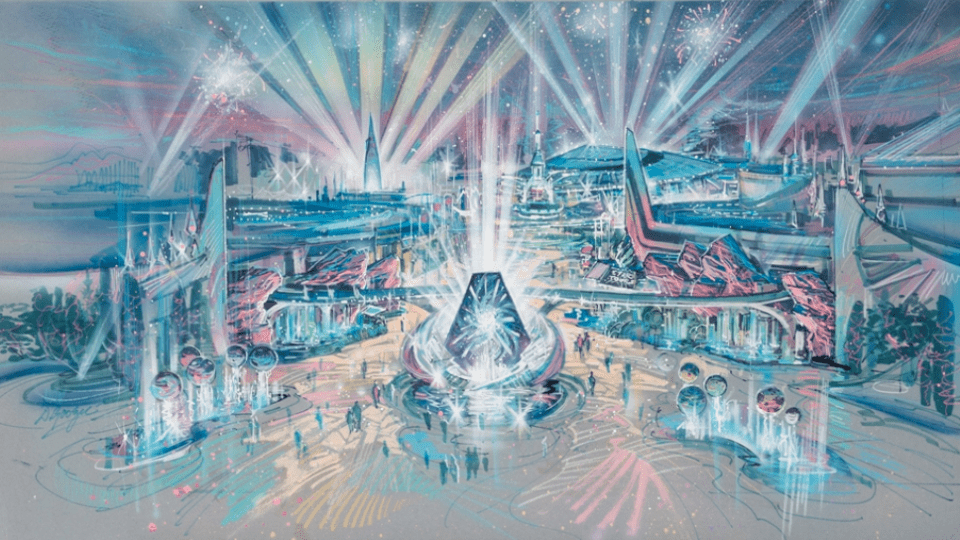
Still, production on this Xenomorph-free Alien Encounter pressed onward. It had to! After all, it would be a centerpiece of the newly-evergreen, Space-Age-free Tomorrowland en route to Disneyland in California: the subject of an in-depth Possibilityland: Tomorrowland 2055. Set a hundred years after Disneyland’s opening, this timeless Tomorrowland would be transformed into an organic alien oasis powered by glowing gems burst forth from the ground, acting as a homing beacon for interstellar civilizations around the galaxy…
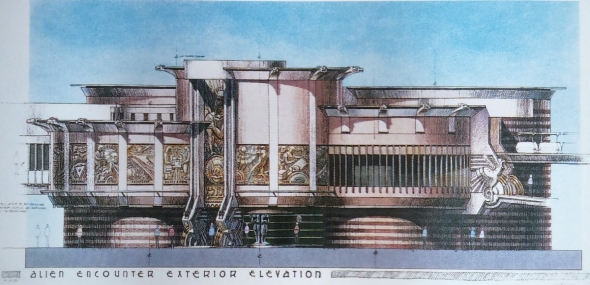
A convincingly sci-fi setting prepared for it, Alien Encounter could at last make its debut in those two circular theaters at the rear of Disneyland’s Tomorrowland… And unlike the glowing, prismatic land’s entry or the playful landed alien ships around it, there would be something ominous about this Alien Encounter…

Since Imagineers were now starting from scratch in introducing a completely original backstory, the architecture of Disneyland’s Alien Encounter needed to convey that something dark resided within… An odd, techno-deco style equally imposing and inviting, as evidenced in the Passholder-exclusive rare concept art below.

Pillars carved like hunched humans would hold aloft great stone reliefs of almighty beings in the sky, and carved gargoyles of dragon-like insectoid aliens pierced out from the rooftops as steam bellowed from its roof.
Clearly interpolating the cold, biomechanical illustrations of H. R. Giger (whose surrealist prints inspired the Xenomorph, which he co-designed with filmmakers), the exterior of the West Coast Alien Encounter would paint a picture of an imposing, Gotham-esque laboratory; a steampunk-gothic facility that’s technological and grand… and harboring something dark.
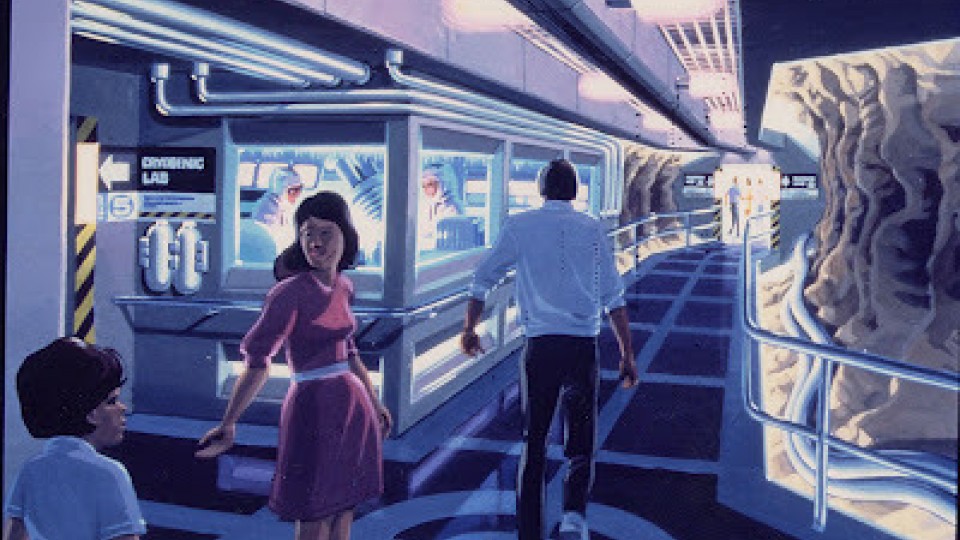
Inside, guests would be funneled into a briefing room, introducing an eerie, amoral alien mega-corporation before passing through a Grand Hallway showing their otherworldly scientists at work on chilling experiments… Then, they’d endure a small-scale demonstration of teleportation before being ushered into one of the two Mission to Mars theaters for the real highlight — something new… something terrifying…
Disneyland’s Mission to Mars closed November 2, 1992 to begin its transformation. Except, as we know, Alien Encounter never opened at Disneyland. In fact, Tomorrowland 2055 was scrapped entirely. When Disneyland Paris opened in 1992, the massively overbuilt resort was met with near-immediate financial collapse. A massive turning point for Disney Parks, nearly all ambitious projects were cancelled — including Disneyland’s Tomorrowland 2055.

Okay, so plans for Alien Encounter to debut at Disneyland were dashed.
But Michael Eisner was still certain Alien Encounter would be the next great hit from Imagineering, and that it would be an inexpensive add that could be exported across the world! The difference is that now, it would need to skip its planned Disneyland debut and instead be prototyped at Magic Kingdom, where it was too late to cancel the New Tomorrowland en route.
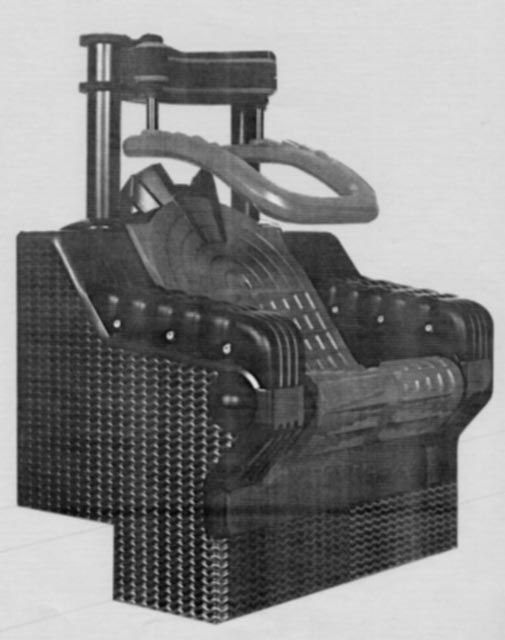
With its launch shifted from Anaheim to Orlando, designers raced to put the finishing touches into the show before its effects-equipped, binaural-speaker seats and Audio-Animatronics figures were shipped out for their Orlando installation. Imagineers hoped that their plans to very simply retrofit the Mission to Mars theater with special-effects-packed seats (right) would make the attraction’s Test & Adjust phase roll on smoothly… Little did they know that the version of Alien Encounter they’d designed was just the beginning.
Forget Tomorrowland 2055… The final version of Alien Encounter was heading across the country, and to a very different – but equally timeless – Tomorrowland.
The City of Tomorrow(land)

Though Disneyland’s New Tomorrowland was now officially delayed thanks to the financial pitfalls of the new Parisian resort, Orlando’s New Tomorrowland was already under construction, and Alien Encounter would make its grand debut there.
Dispensing with the “outdated” aesthetic of ’70s simplicity, Magic Kingdom’s New Tomorrowland would take the future in an entirely different direction. Like Discoveryland, it would be a vision of tomorrow rooted in the past. But rather than Paris’ 19th century literary fantasy future, this Tomorrowland would be stylized as a sci-fi city born of Buck Rogers and other 1930s pulp serial space comics, fused with art deco embellishments and Factory Pomo design elements and aesthetics — the “future that never was.”
Admittedly, there was something briefly brilliant about this New Tomorrowland — perhaps Disney’s first stateside adopter of the truly immersive world-building practiced in Paris. This pulpy metropolis of mechanical palm trees, robotic newsboys, brushed metal fins, saturated cogs, and intergalactic payphones wasn’t just a land, it was a world. Each of the area’s rides, shows, attractions, and even restaurants was meant to be part of the “real” functioning city of Tomorrowland, playing a role in the city’s narrative.
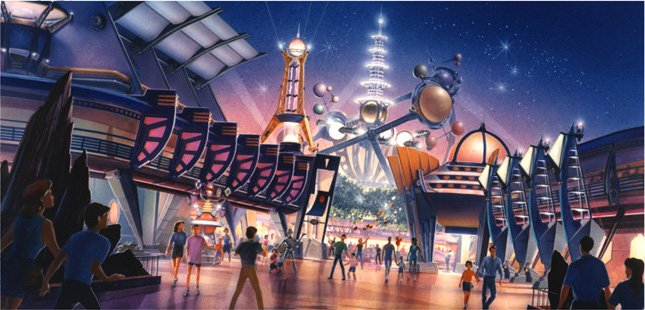
For example, the land’s entry became the Avenue of Planets, dotted with municipal signage for the city and neon signs in alien languages; the long-running Peoplemover became the Tomorrowland Transit Authority — the city’s functioning mass transit system (with on-ride announcements suggesting further lines connecting to suburbs and other inner city stations); Space Mountain was wrapped in as the city’s space port, while Cosmic Ray’s Starlight Cafe (home of famed lounge singer Sonny Eclipse) played the role of a real downtown eatery frequented by interstellar visitors.
Those two mirrored showbuildings along the land’s entry were wrapped into the story, too. To the south, the Tomorrowland Science Center housed the Lost Legend: The Timekeeper, explained as a rotating exhibition on display. The north building, meanwhile, was puzzlingly dark. With dominating angular towers, industrial iron fins, and sharp metallic edges, the building was somehow… sinister. As part of Tomorrowland’s continuity, the Transit Authority sailed by and explained that this unusually unfriendly building was the Tomorrowland Interplanetary Convention Center.
Even when New Tomorrowland opened in 1994, the “Convention Center” remained closed. Inside, Imagineers were ushering in the Martian technology corporation X-S Tech, whose teleportation technology would be at the heart of the ExtraTERRORestrial Alien Encounter. With a few finishing touches yet to go, the new attraction opened to “test and adjust” audiences… and boy did Imagineers have to adjust.
Test and adjust
The show took in its first test audiences in December 1994, with guests allegedly reporting that the attraction was much too intense. Insiders say that while the first visitors expected Alien Encounter to be thrilling, they hadn’t expected to be legitimately uneasy afterward. Even though Imagineers hadn’t used the Xenomorph, they’d still crafted a creature, story, and effects that audiences were unprepared for. Before the attraction could officially open, they’d need to do some retooling.

First, Imagineers rewrote the pre-show. An original version featured the sarcastic cyborg T.O.M. (Technobotic Oratorical Mechanism, voiced by SNL alum and comedian Phil Hartman) humorously demonstrating X-S Tech’s teleportation technology on a small scale by accidentally frying a hapless alien. Though the demonstration went wrong, the mild pre-show failed to prepare audiences for the sincerely frightening experience beyond.
As such, the pre-show was re-written with T.O.M. becoming the more sinister and amoral S.I.R. (Simulated Intelligence Robotic) with famed actor Tim Curry taking on the role. The unsettling and even disturbing pre-show, it was hoped, would weed out crowds put off by the dark tone, acting like a filter to more closely match the horror-based experience of the main show.
Speaking of which, the attraction itself needed some fine-tuning based on test audiences. After Eisner’s first time experiencing his pet project, he reported that there were far too many plot holes and that the story was much too complex, with long bouts of exposition between moments of action. There were also reports that too much of the show took place in absolute darkness, requiring that Imagineers create additional on-screen visuals and occasional “sparks” to illuminate the show scene, just to re-orient guests.
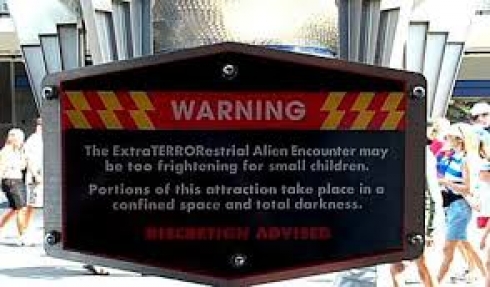
Plus, it turned out that guests were screaming longer than expected, making important dialogue and plot points impossible to understand. Imagineers had to re-pace the show to account for audience reactions, and in 1994, that required extensive reprogramming of every computer system separately as each show element — sound, lighting, fog, animatronics, in-seat effects, and video — was re-sequenced and re-timed.
After six weeks of soft-opening for testing and adjusting without ever officially premiering, the attraction went dark. Rumors swirled among visitors, Cast Members, and fans about why Alien Encounter had closed. Was it too scary? Not scary enough? Flyers noted that the ride may have missed its December ’94 opening with the rest of New Tomorrowland, but promised that Alien Encounter would be ready by Easter.
Unfortunately, that didn’t happen either. When Alien Encounter finally opened in June 1995, insiders say that Eisner had lost all interest and passion in the project, privately declaring it a lost cause. Maybe it was the $10 million needed to revise the show for six months. It might also have been that Eisner finally agreed with his senior Imagineers: Alien Encounter was just too scary for Magic Kingdom. But the show must go on, and Alien Encounter did. Shall we step inside?


